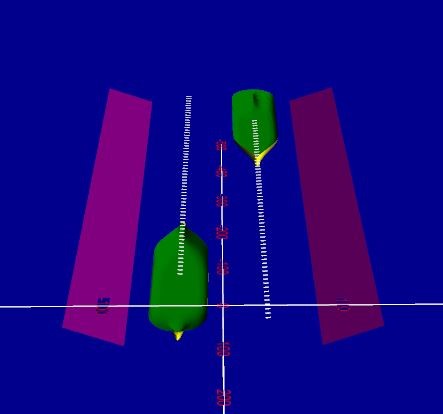Vessel Hydrodynamic Modeling
The team at MITAGS has developed an extensive library of simulated ship models; comprising vessels of different tonnage, dimension, and hull forms; including, container ships, tankers, ASD & Voith Schneider tug boats, gas carriers, ice breakers, fishing vessels, passenger ships, ferries, and special purpose naval and commercial vessels. Mathematical models of the ships and ship equipment, physical forces, and effects have been based on the results of research carried out by ship/tug Captains and hydrodynamicists and comply with the highest possible global standards.
ROPES (Research on Passing Effects on Ships) Program
For studies involving ship to ship passing, MITAGS uses the ROPES Program. It is a software that was created and owned by MARIN’s Joint Industry Project. This program allows us to validate the six degree-of-freedom forces (surge, sway, heave, roll, pitch, and yaw) between the ships and compare the data to our simulator’s output.
ROPES (Research on Passing Effects on Ships) is part of MARIN’s JIP (Joint Industry Project) developed to predict the ship to ship interaction forces in shallow water in open or restricted waters. The effects on port and channel geometry have also been included in the software.
As described in the ROPES User Manual, the main features of the program are:
- The computations are based on 3-dimensional flow calculations for real hull forms
- The flow calculations are based on the so-called “Double-body flow” method
- More than one moored or passing vessel can be included in the computations
- The output of the computations is in the form of time-domain records of the 3 forces and 3 moments acting on the vessels
- The computations are based on a database of “Parent” hull forms. The hull forms can be transformed to arbitrary main dimensions and displacement volume before the hydrodynamic computations are carried out.
- The program is supplied with 5 standard hull forms i.e. a Tanker, Container vessel, LNG carrier, a typical inland barge and a rectangular barge.
- Users of the program may add models of their own vessels. The file structure is given in this manual.
- Operation of Ropes is through a graphical user interface
The program is recommended by PIANC report number 153-2016 (Chapter 7.3.5) as “the most recent industry guidance on passing vessel analysis is a product of a Joint Industry Project, resulting in the computer program ‘ROPES’” (page 80).
Simulation Capabilities and Facilities
MITAGS has simulation research capabilities at our campuses in Baltimore, Maryland and Seattle, Washington.
Our team of experts, strategic partners and simulation facilities are unequaled.
Learn more!
To learn more about our Hydrodynamic Modeling capabilities, please enter your email address to download our Simulation Facilities & Capabilities Guide, then turn to page 15!

